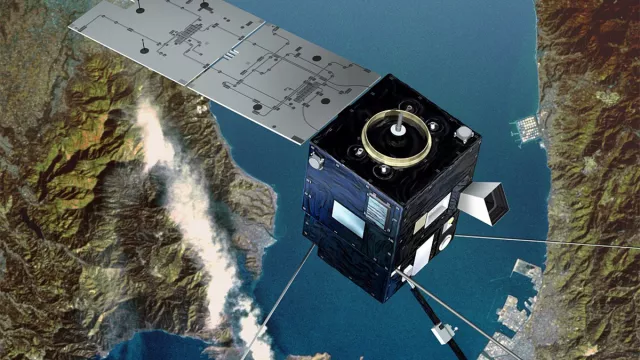Launched in 2004, the Demeter satellite observed electric and magnetic signals in Earth’s ionosphere for more than six years. The data it collected yielded more than 300 scientific articles.
Key information
| Mission | Study Earth’s electromagnetic environment |
|---|---|
| Domain | Earth observation |
| Launch date | 29 June 2004 |
| Partners | CNRS, French research laboratories (LATMOS, IPGP, IRAP, Observatoire Radioastronomique de Nançay, DASE (ex-LDG)/CEA, LESIA, OPGC), Clermont Auvergne University, ESA, Centrum Badan Kosmicznych (CBK, Poland), University of Electro-Communications (UEC, Japan) |
| Where | Near-sun-synchronous circular orbit (715 km) to December 2005 then lowered to 660 km |
| Lifetime | 2 years (nominal), extended by 3 years. End of orbital science mission: December 2010 Satellite retired from service: March 2011 |
| Status | Completed |
Key figures
- 130 kg: satellite mass
- 5 instruments
- 300+ scientific publications
- 7 contributing French laboratories
Key milestones
- March 2011: Satellite retired from service
- December 2010: End of science mission
- 29 June 2004: Demeter satellite launched by Dnepr-LV
Project in brief
Does seismic and volcanic activity on the ground affect the electromagnetic environment of Earth’s atmosphere? Satellites have recorded some strange coincidences. The aim of Demeter (Detection of Electro-Magnetic Emissions Transmitted from Earthquake Regions) was to obtain more-conclusive proof and explanations. Even though Demeter did detect seismic activity affecting the ionosphere before certain tremors, the disturbances were so weak that they could only be highlighted statistically. Scientists therefore still cannot say if such disturbances of the electric field will appear before a specific tremor, and more broadly, whether we might one day be able to forecast earthquakes.
An original feature of Demeter was its ability to measure transient very-low-frequency (VLF) electromagnetic phenomena, thus providing a new window into the lower region of the ionosphere that had hitherto been studied very little, as it is too high for balloons to reach and too low for satellites. Thanks to Demeter’s particle detector, research scientists have also been able to study the compression of Earth’s magnetic field during very strong magnetic storms triggered by variations in the Sun’s activity.
Weighing 130 kilograms, Demeter was lofted into a 715-km circular orbit on 29 June 2004 from the Baikonur Cosmodrome in Kazakhstan by a Dnepr-LV launcher. The last science work plan commands were uploaded to the satellite in December 2010.
CNES’s role
CNES was in charge of developing the Demeter system and prime contractor for the technological mission centre and payload. The first satellite built around CNES’s Myriade spacecraft bus, Demeter demonstrated the ability to conduct innovative, low-cost missions. The LPC2E environmental and space physics and chemistry laboratory was prime contractor for the science payload and responsible for the Demeter science mission centre. Other research laboratories in France—LATMOS, IPGP, IRAP, the US Nançay science unit at the Paris Observatory, LDG/CEA, LESIA and OPGC—Europe and Japan also contributed to the mission. Demeter’s results have nurtured new missions like Taranis.
Contacts
Internal Geophysics, Geodynamics and Geodesy subject matter expert
Felix Perosanz
E-mail: felix.perosanz at cnes.fr


